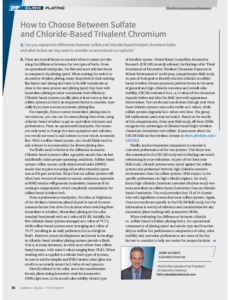Technical & Safety Data
Log in or sign up to access technical data, safety data, applicator approvals and troubleshooting guides.
“When evaluating the differences between chloride vs. sulfate-based trivalent plating baths, you’ll want to consider the operational components of plating speed and anode type and functionality as well as the performance components of color, color stability and corrosion performance,” says Mark Schario from Columbia Chemical.
Products Finishing
Expert Clinic/Plating
Mark Schario, Chief Technology Officer ~ Columbia Chemical
Q. Can you explain the differences between sulfate and chloride-based trivalent chromium baths and what factors we may want to consider as we evaluate our options?
A. There are several factors to consider when it comes to evaluating the difference between the two types of baths. From an operational standpoint, the first and most relevant factor to compare is the plating speed. When making the switch to decorative trivalent plating, many shops look at their existing line layout and timing and want to be able to maintain as close to the same process and plating speed they have with hexavalent plating in order to maintain their efficiency. Chloride-based systems usually plate at least twice as fast as sulfate systems, so this is an important factor to consider, especially if you have a return automatic plating line.
For example, if your current hexavalent plating time is two minutes, you can use the same plating time when using chloride-based trivalent to get an equivalent thickness and performance. From an operational standpoint, this means you only need to change the tank equipment and solution; you would not need to add stations to your return automatic line. With a sulfate-based system, you would likely need to add stations to accommodate the slower plating time.
You’ll also need to factor in the difference in anodes. Chloride-based systems utilize a graphite anode that can last indefinitely under proper operating conditions. Sulfate-based systems utilize a more costly mixed-metal oxide (MMO) anode that requires recoating either after extended operation or if it gets scratched. Shops that use sulfate systems will often have two sets of anodes to ensure continuous operation as MMO anodes will generate hexavalent chromium if the coating is compromised, which completely contaminates the sulfate-based trivalent bath.
From a performance standpoint, the color, or brightness, of the trivalent chromium plated deposit is one of the most common factors that drive the decision when switching from hexavalent to trivalent. Hexavalent plating set the color standard benchmark with an L value of 81-83. Initially, the first chloride-based systems averaged an L value of 74-75, while sulfate-based systems were averaging an L value of 75-77, resulting in an early preference due to a brighter finish. However, recent developments and newer technology in chloride-based trivalent plating systems provide a finish that is, in many instances, as white as or whiter than sulfate-based systems, with some L values ranging from 78-81. When working with a supplier to evaluate both types of systems, be sure to ask for samples and BYK-Gardner color/gloss test results to accurately assess the L value of each process.
Directly related to the color, and a key consideration for any plater doing decorative work for automotive OEMs right now, is the color stability of each type of trivalent system. United States Council for Automotive Research (USCAR) recently released the findings of its “Final Assessment of Decorative Trivalent Chromium Exposure in Winter Environments” which was a multi-year, comprehensive field study. As part of the original goal to identify whether chloride or sulfate-based trivalent chrome processes perform better in the areas of general and high-chloride corrosion and overall color stability, USCAR evaluated the L, a, b values of the chromium deposits before and after the field tests with appearance observations. Test results and conclusions through year three show chloride systems were color stable on L values, while sulfate systems degraded in L values over time. The group felt replacement parts may not match. Based on the results of this comprehensive, three-year field study, all three OEMs recognize the advantages of chloride-based bright trivalent chromium chemistries over sulfate. (Learn more about the USCAR field test for trivalent chrome at https://www.pfonline.com/articles/summary-report-uscar-field-test-on-trivalent-chromium .)
Finally, another important component to consider is corrosion performance of the two systems. This factor was also examined in the USCAR study and its findings are worth referencing in your evaluation. As part of the three-year field study, chloride systems were tested against the sulfate systems and performed better in high-chloride corrosive environments than the sulfate systems. With respect to the specific performance in high-chloride regions, the study found high-chloride chromium corrosion (Russian mud) was more prevalent on sulfate-based chemistries than on chloride-based chemistries. The study revealed that 13 of 14 chemistries with significant chrome loss were sulfate systems. Again, these test results are specific to the USCAR field study, but the information is worthy of reference and consideration for any decorative plater working with automotive OEMs.
When evaluating the differences between chloride vs. sulfate-based trivalent plating baths, the operational components of plating speed and anode type and functionality as well as the performance components of color, color stability and corrosion performance are some of the key factors to consider to help you make the proper decision.
This article was published in the March 2024 issue of Products Finishing magazine.